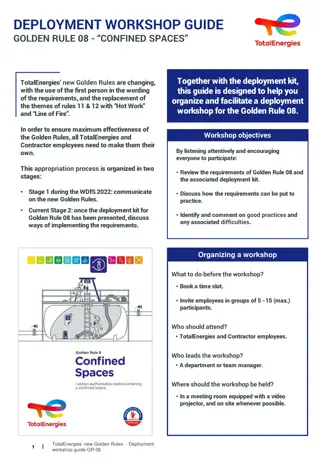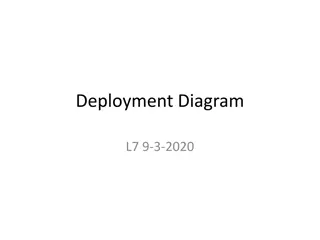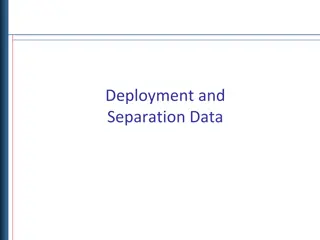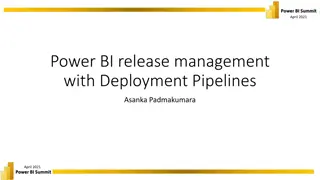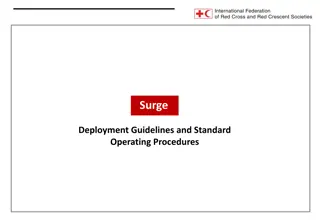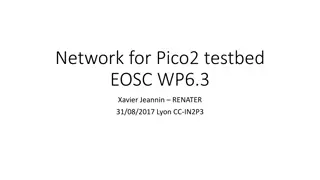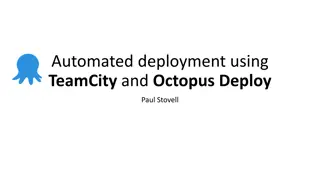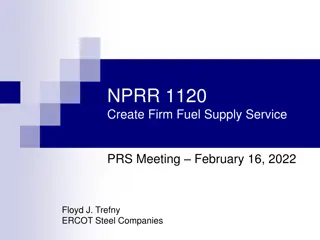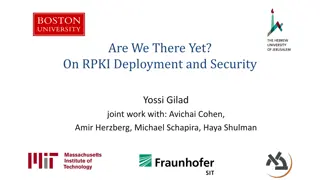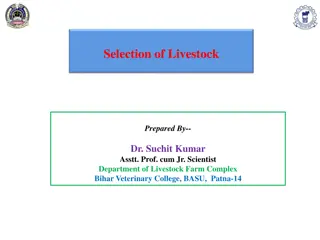Streamlining AI Project Selection and Deployment Process for Business Development
Explore the key elements of AI transformation, from choosing projects to transitioning from prototypes to operational deployment. Learn how to leverage data science, MLOps, DevOps, and data engineering to drive high-impact projects, improve models iteratively, and ensure seamless integration into workflows. Enhance stakeholder collaboration, monitoring, and performance evaluation for successful AI implementation.
Download Presentation

Please find below an Image/Link to download the presentation.
The content on the website is provided AS IS for your information and personal use only. It may not be sold, licensed, or shared on other websites without obtaining consent from the author.If you encounter any issues during the download, it is possible that the publisher has removed the file from their server.
You are allowed to download the files provided on this website for personal or commercial use, subject to the condition that they are used lawfully. All files are the property of their respective owners.
The content on the website is provided AS IS for your information and personal use only. It may not be sold, licensed, or shared on other websites without obtaining consent from the author.
E N D
Presentation Transcript
AIOPS HVORDAN VELGE UT KI PROSJEKTER OG G FRA PROTOTYP TIL DRIFT Volker Hoffmann <volker.hoffmann@sintef.no> Energytics Avslutningsseminar, 10 Juni 2020
Context: Elements on AI Transformation Cases & Value Data Techniques & Tools Workflow Integration Open Culture Ecosystems 2 Source: Bughin et al. McKinsey Global Institute, Artificial intelligence, June 2017.
Elements on AI Transformation Cases & Value Data Techniques & Tools Workflow Integration Open Culture Ecosystems 3
Framework: Concept to Impact Cases & Value Data Techniques & Tools Workflow Integration Open Culture Ecosystems 4
Business Development & Data Science MLOps & DevOps Data Engineering Business Drivers Data Science Model Versioning Model Deployment Data Pipelines Bring together internal and external stakeholders with data scientists. Generate ideas about processes that can be improved with data- driven insights. Prepare, process, and analyze data to assess validity of ideas generated together with business stakeholders. For successful applications, iteratively improve models by model tuning, feature engineering, and addition of new data sources. Make models available for integration into new and existing workflows. Serve models through APIs, so they are agnostic to to existing infrastructure. To exploit operational models, build robust data ingestion pipelines. This enables real- and near-time processing and continuous improvement of models. Set performance indicators and requirements so that results can be decision gated. Log and document experiments and keep stakeholders updated using performance indicators. Track and archive model versions and associated training data (data provenance). Automate rollout/rollback through by continuous integration and deployment (CI/CD) with performance monitoring. Archive all inbound data to allow data scientists and business stakeholders to develop new and iterate on existing improvements. Facilitated by frameworks such as Design Thinking, 10 Types of Innovation, or types of Business Process Analysis (LEAN, Six Sigma). This is a heavily iterative process as hypotheses become invalidated, are adjusted, and finally validated. This ensures reproducibility and enables automated rollout (and rollback) when models improve (or fail). This ensures that best performing models are automatically deployed and that misbehaving models are rolled back. Python, R, Julia Spark, Docker, Kubernetes Kafka, MQTT, Avro, Thrift 5
Business Development & Data Science MLOps & DevOps Data Engineering Business Drivers Data Science Model Versioning Model Deployment Data Pipelines Connect with stakeholders Keep stakeholders updated Iteratively improve models Add models to workflows Build robust pipelines Low hanging fruits High-impact projects Build prototypes Log experiments Feature engineering Hyperparameters Serve through APIs Monitor performance Operate on real-time data Archive data Set performance indicators Set performance targets Track and archive models Track and archive data Automate deployment Automate rollback Use Design Thinking, 10 Types of Innovation, LEAN, Six Sigma, etc Iterate, iterate, iterate Make it reproducible Python, R, Julia Spark, Docker, Kubernetes Kafka, MQTT, Avro, Thrift 6
Business Development & Data Science MLOps & DevOps Data Engineering Business Drivers Data Science Model Versioning Model Deployment Data Pipelines Connect with stakeholders Keep stakeholders updated Iteratively improve models Add models to workflows Build robust pipelines Low hanging fruits High-impact projects Build prototypes Log experiments Feature engineering Hyperparameters Serve through APIs Monitor performance Operate on real-time data Archive data Set performance indicators Set performance targets Track and archive models Track and archive data Automate deployment Automate rollback Use Design Thinking, 10 Types of Innovation, LEAN, Six Sigma, etc Iterate, iterate, iterate Make it reproducible Python, R, Julia Spark, Docker, Kubernetes Kafka, MQTT, Avro, Thrift 7
Business Development & Data Science MLOps & DevOps Data Engineering Business Drivers Data Science Model Versioning Model Deployment Data Pipelines Connect with stakeholders Keep stakeholders updated Iteratively improve models Add models to workflows Build robust pipelines Low hanging fruits High-impact projects Build prototypes Log experiments Feature engineering Hyperparameters Serve through APIs Monitor performance Operate on real-time data Archive data Set performance indicators Set performance targets Track and archive models Track and archive data Automate deployment Automate rollback Use Design Thinking, 10 Types of Innovation, LEAN, Six Sigma, etc Iterate, iterate, iterate Make it reproducible Python, R, Julia Spark, Docker, Kubernetes Kafka, MQTT, Avro, Thrift 8
Business Development & Data Science MLOps & DevOps Data Engineering Business Drivers Data Science Model Versioning Model Deployment Data Pipelines Connect with stakeholders Keep stakeholders updated Iteratively improve models Add models to workflows Build robust pipelines Low hanging fruits High-impact projects Build prototypes Log experiments Feature engineering Hyperparameters Serve through APIs Monitor performance Operate on real-time data Archive data Set performance indicators Set performance targets Track and archive models Track and archive data Automate deployment Automate rollback Use Design Thinking, 10 Types of Innovation, LEAN, Six Sigma, etc Iterate, iterate, iterate Make it reproducible Python, R, Julia Spark, Docker, Kubernetes Kafka, MQTT, Avro, Thrift 9
Business Development & Data Science MLOps & DevOps Data Engineering Business Drivers Data Science Model Versioning Model Deployment Data Pipelines Connect with stakeholders Keep stakeholders updated Iteratively improve models Add models to workflows Build robust pipelines Low hanging fruits High-impact projects Build prototypes Log experiments Feature engineering Hyperparameters Serve through APIs Monitor performance Operate on real-time data Archive data Set performance indicators Set performance targets Track and archive models Track and archive data Automate deployment Automate rollback Use Design Thinking, 10 Types of Innovation, LEAN, Six Sigma, etc Iterate, iterate, iterate Make it reproducible Python, R, Julia Spark, Docker, Kubernetes Kafka, MQTT, Avro, Thrift 10
Tools to Speed You Up Cases & Value Data Techniques & Tools Workflow Integration Open Culture Ecosystems 11
Neptune Neptune is a tracker for experiments with focus on Python. It is a hosted service. Experiments are tracked by using library hooks to register (model) parameters, evaluation results, and upload artifacts (such as models, hashes of training data, or even code). The library can track hardware usage and experiment progress. The results can be analyzed and compared on a website. There are also collaborative options. Neptune has integrations with Jupyter notebooks, various ML libraries, visualizers (HiFlow, TensorBoard), other trackers (MLFlow), and external offerings (Amazon Sagemaker). They provide an API to query results from experiment. This can be used to feed CI/CD pipelines for model deployment. $ conda create --name neptune python=3.6 $ conda activate neptune $ conda install -c conda-forge neptune-client $ cd /somewhere 12 ---> https://ui.neptune.ai/ ---> Create Account, Log In, Getting Started
MLFlow MLFlow is an experiment tracker and generic model server. It can be self-hosted. Experiments are tracked by using library hooks to register (model) parameters, evaluation results, and upload artifacts (such as models, hashes of training data, or even code). Artifacts can be logged to local, remote, or cloud storage (S3, GFS, etc). Results can be analyzed through a web UI and CSV export is available. Models are packaged as a wrapper around the underlying format (Sklearn, XGBoost, Torch, etc). They can be pushed to Spark for batch inference or served through REST. There are CLI, Python, R, Java, and REST APIs for further integration with CI/CD pipelines. Models can be pushed to cloud services (SageMaker, AzureML, ...). $ conda create --name mlflow python=3.6 $ conda activate mlflow $ conda install -c conda-forge mlflow $ cd /somewhere $ mlflow ui ---> http://localhost:5000 ---> https://mlflow.org/docs/latest/quickstart.html 13
Kubeflow Kubeflow is essentially a self-hosted version of the Google AI platform. It uses Kubernetes to abstract away infrastructure. Kubeflow can deploy Jupyter notebooks, run pipelines for data processing and model training (scheduled, on-demand), organize runs, archive models and other artifacts, and expose models through endpoints. Pipelines are compute graphs and are described in Python with a DSL. Their components are wrapped as Docker images. It integrates with GCP so it can elastically scale to the cloud compute and storage (e.g., distributed model training). It also integrates with offerings such as BigQuery or Dataproc. https://www.kubeflow.org/docs/started/workstation/getting-started-minikf/ The solution is heavy and complex but enables rapid scale-out. It is especially applicable if infrastructure is already managed through Kubernetes. $ cd /somewhere $ vagrant init arrikto/minikf $ vagrant up 14 ---> http://10.10.10.10
Pachyderm Pachyderm is a versioning system and execution environment for data and processing pipelines. Hosted and self-hosted options exist. At its core is data provenance. Data is committed to a repository and acted upon by processors in pipelines. The results (data and other artefacts like models) are committed back into a repository. By design, all use of data is traceable through pipelines. Pipelines are described in JSON and processors are packaged as Docker images. Pachyderm can integrate (but not deploy) Jupyter and can push/pull data from cloud stores (S3, etc). Pachyderm is built on top of Kubernetes, so can easily scale-out and run in various clouds. Self- hosting comes with the usual Kubernetes complexity. $ cd /somewhere $ download from (https://github.com/pachyderm/pachyderm/releases) $ tar xfvz release_filename_linux_amd64.tar.gz $ pachctl version --client-only 15 ---> https://docs.pachyderm.com/latest/pachub/pachub_getting_started/ ---> https://docs.pachyderm.com/latest/getting_started/beginner_tutorial/
Recommendations Containers and Provenance ScaleUp on Google Hosted One- Stop Shop Remain Undecided Just Getting Started Track Experiments Archive Some Models Work on Low Hanging Fruits Expect Scaling? Integrate w/ Google Cloud? Running Kubernetes? Want pipelines? Want containers? Want data provenance? Deploy models? Track data? Need end-to-end? No idea? Try Neptune or MLFlow. Try Kubeflow. Try Pachyderm. Try Dataiku, SageMaker, AzureML, DataBricks, or Google AI Platform. Try Neptune or MLFlow. !!! Complex !!! 17
Conclusion Cases & Value Data Techniques & Tools Workflow Integration Open Culture Ecosystems 18 Source: Bughin et al. McKinsey Global Institute, Artificial intelligence, June 2017.
More? Smartgridsenterets Webinar 28 May 2020 https://www.youtube.com/watch?v=o5_TrwbkNiI https://cheleb.net/talks/2020-05-28_AIOps_Webinar.pdf 19


